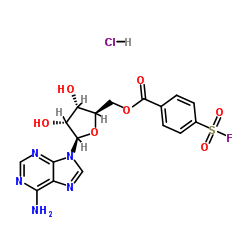FSBA

FSBA structure
|
Common Name | FSBA | ||
|---|---|---|---|---|
| CAS Number | 78859-42-4 | Molecular Weight | 489.863 | |
| Density | N/A | Boiling Point | N/A | |
| Molecular Formula | C17H17ClFN5O7S | Melting Point | N/A | |
| MSDS | USA | Flash Point | N/A | |
|
Radioresistant Sf9 insect cells undergo an atypical form of Bax-dependent apoptosis at very high doses of γ-radiation.
Int. J. Radiat. Biol. 89(12) , 1017-27, (2013) To investigate the underlying mechanisms of cell-death at extremely high doses of radiation in radioresistant Spodoptera frugiperda-9 (Sf9) insect cells.Morphology, cell proliferation and DNA-fragmentation analysis was performed at 500-2000 Gy. Changes in int... |
|
|
Wortmannin inactivates phosphoinositide 3-kinase by covalent modification of Lys-802, a residue involved in the phosphate transfer reaction.
Mol. Cell. Biol. 16 , 1722-1733, (1996) Wortmannin at nanomolar concentrations is a potent and specific inhibitor of phosphoinositide (PI) 3-kinase and has been used extensively to demonstrate the role of this enzyme in diverse signal transduction processes. At higher concentrations, wortmannin inh... |
|
|
Vesicular transport and apotransferrin in intestinal iron absorption, as shown in the Caco-2 cell model.
Am. J. Physiol. Gastrointest. Liver Physiol. 290 , G301-G309, (2006) The potential roles of vesicular transport and apotransferrin (entering from the blood) in intestinal Fe absorption were investigated using Caco-2 cell monolayers with tight junctions in bicameral chambers as a model. As shown previously, addition of 39 micro... |
|
|
The ATP-binding site of brain phosphatidylinositol 4-kinase PI4K230 as revealed by 5'-p-fluorosulfonylbenzoyladenosine.
Int. J. Biochem. Cell Biol. 33(3) , 249-59, (2001) The ATP-binding site of purified bovine brain phosphatidylinositol 4-kinase 230 (PI4K230) was studied by its reaction with 5'-p-fluorosulfonylbenzoyladenosine (FSBA), an ATP-like alkylating reagent. Four hundred to eight hundred micromolar FSBA inactivated PI... |
|
|
Kinetic mechanism and ATP-binding site reactivity of p38gamma MAP kinase.
FEBS Lett. 461(3) , 323-8, (1999) Activated p38gamma MAP kinase exhibited significant basal ATPase activity in the absence of a kinase substrate, and addition of a phosphoacceptor substrate increased k(cat)/K(m)20-fold. AMP-PCP was competitive with ATP binding and non-competitive with phospho... |
|
|
5'-p-Fluorosulfonylbenzoyl adenosine inhibits progesterone synthesis in human placental mitochondria.
Biochim. Biophys. Acta 1585(1) , 11-8, (2002) The human placental mitochondria have an ATP-diphosphohydrolase (apyrase) activity. In this paper we characterized the effect of 5'-p-fluorosulfonylbenzoyl adenosine (FSBA) on placental apyrase, and its repercussion on progesterone synthesis and oxygen consum... |
|
|
Clopidogrel (Plavix) and cardiac surgical patients: implications for platelet function monitoring and postoperative bleeding.
Platelets 15(5) , 325-32, (2004) The use of clopidogrel (Plavix), an inhibitor of adenosine diphosphate (ADP)-induced platelet aggregation, has been proven to reduce ischemic events in cardiovascular patients, but little information is available for optimal monitoring of platelet function in... |
|
|
Inhibition of multidrug resistance-linked P-glycoprotein (ABCB1) function by 5'-fluorosulfonylbenzoyl 5'-adenosine: evidence for an ATP analogue that interacts with both drug-substrate-and nucleotide-binding sites.
Biochemistry 50 , 3724-3735, (2011) 5'-Fluorosulfonylbenzonyl 5'-adenosine (FSBA) is an ATP analogue that covalently modifies several residues in the nucleotide-binding domains (NBDs) of several ATPases, kinases, and other proteins. P-glycoprotein (P-gp, ABCB1) is a member of the ATP-binding ca... |
|
|
A liquid chromatography/mass spectrometry-based method for the selection of ATP competitive kinase inhibitors.
J. Biomol. Screen. 10(5) , 447-55, (2005) The currently approved kinase inhibitors for therapeutic uses and a number of kinase inhibitors that are undergoing clinical trials are directed toward the adenosine triphosphate (ATP) binding site of protein kinases. The 5'-fluorosulfonylbenzoyl 5'-adenosine... |
|
|
Inhibition of ATP-induced cAMP formation by 5'-p-fluorosulfonylbenzoyladenosine in NG108-15 cells.
Naunyn Schmiedebergs Arch. Pharmacol. 358(2) , 153-9, (1998) ATP is known to increase intracellular cAMP levels in NG108-15 cells via a novel purinoceptor and this response is inhibited by the P1 purinoceptor antagonist methylxanthine. In the present study, we examined the effects of 5'-p-fluorosulfonylbenzoyladenosine... |